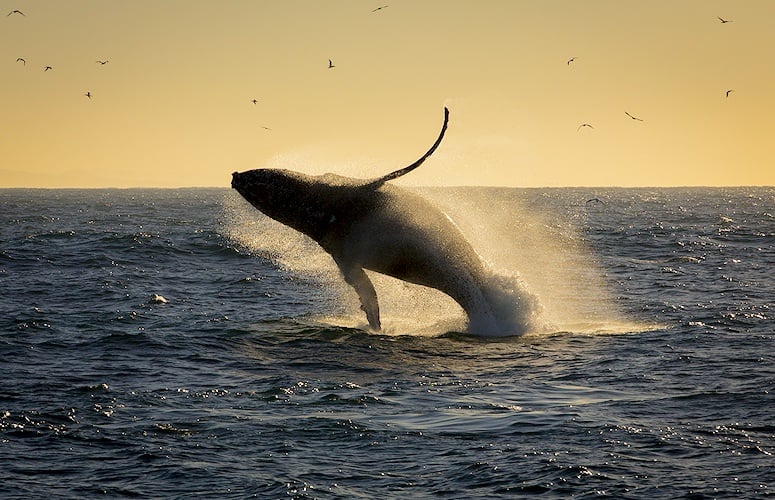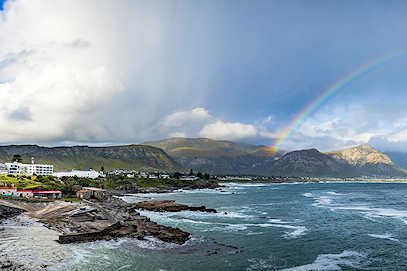The Whale Route is named for the remarkable number of whales that frequent the coastal waters. South Africa is one of the best destinations for encounters with sea creatures, with annual visits from Southern right and humpback whales between June and November. The Southern right whales migrate from Antarctica to warmer climates to give birth.
Need Advice?The route stretches from Rooi Els to Quoin Point. The best spots to see the whales are Hermanus, Gansbaai, Kleinmond, and the Garden Route. Hermanus is a popular viewing area because of the 'whale crier' who announces the arrival of the whales.

There are boat trips offered which take one up close to the whales, bearing in mind that in South Africa, there is a restriction on getting too close. Boats are allowed up to 300 meters from the whales with a special permit. Towards the end of October, the Southern right whales start leaving South African waters, though many holidaymakers still get to see some of the later stragglers in December.
Immerse yourself in the diversity of the Cape Floral Region by taking on one of the hikes at the Fernkloof Nature Reserve. The journey includes beautiful scenic views of the mountains and the Indian and Atlantic oceans, and an array of flowers and shrubs set within the fynbos will accompany you all the way. Be sure to look out for whales from the vantage point.
It may seem obvious, but it is one of the most remarkable experiences you will ever have. The Southern right whales are so close you almost feel tempted to jump in and join them. If it wasn't for their movements creating waves, and the fact that they are as large as small houses, you would jump in, too.
In addition to great sightings of the gentle giants of the deep, visitors to the Whale Coast can savor some of South Africa's finest wines and explore some of the country's most charming coastal towns, from Betty's Bay to Stanford.
In addition to ample sightings of the gentle giants of the deep, visitors to the Whale Coast can savor some of South Africa's finest wines and also explore some of the country's most charming coastal towns, from Betty's Bay to Stanford.



The Whale Route is situated along the western coast of South Africa, close to Cape Town. Guests visiting the Whale Route will be assisted in transferring from OR Tambo International in Johannesburg to Cape Town International Airport if necessary. Flights to Cape Town are also available from other major airports, such as Durban, if this is not the first destination on your tour.
The Whale Route encompasses various towns and sections of the coastline and starts less than 20 minutes from Cape Town. Guests are met at Cape Town International, from where they will be transported in a private air-conditioned vehicle. The journey along the coastline means that you will be driving around the Hottentots-Holland mountain range from Gordon's Bay to Hermanus.
Whale watching season in South Africa starts in June when the Southern right whales arrive from Antarctica to calve and rear their young. The whales don't all arrive together and can be seen along the coast until December, but in Hermanus, the bests months to visit would be September and October.
It is coincidentally also spring in South Africa, which means that the fynbos and flowers on the route are at their best. Those traveling further north from Cape Town to the Garden Route will also experience the magnificent canola fields. Summers on the Whale Route can be sweltering; in winter, the evenings can be cold.
People have been fascinated by the world's largest animal for thousands of years. Most of this time, whales were exploited for their meat, oil, and blubber. The first recorded whale hunts date back as far as 3 000 BC. The first method people used to hunt whales was by trying to 'scare' whales into bays and onto land, with very little success. Later a drogue – a semi-floating object that attaches to a harpoon – was used. The drogue tired out the whale with drag and buoyancy, giving whalers a chance to come close and make the kill. The first attempt at whaling in South Africa was in 1653 when Commander Jan Van Riebeeck sent a hooker to Saldanha Bay, but it was largely unsuccessful, and the Dutch dropped the idea.
Commercial whaling started in South Africa in the late 18th century and increased drastically throughout the 19th and 20th centuries. Midway through the 20th century, most of the larger whale species had been depleted, and the much less profitable small minke whale was the only whale left to hunt. Whaling was banned in South Africa in 1979. In the 1990s, whale watching became popular and had been growing. Hermanus is one of the top 12 whale-watching destinations worldwide. There are several excellent vantage points to observe these gentle giants, including Siever's Point, Kwaaiwater lookout, and many more.
A large variety of whale species occur in the waters of the coast of South Africa, but only two of these species are regularly seen. The most commonly sighted whale would be the Southern right whale. It was named the 'right' whale as it was easy to hunt, rich in oil, had high-quality baleen, and floated after being killed. Between June and November, the Southern right whales come to shallow waters between Port Elizabeth and Cape Town, where females give birth and rear young in sheltered bays.
The other common specie is the humpback whale. Humpbacks can be identified by long, narrow flippers and a single straight spray when they breathe. They overwinter in tropical and subtropical areas off Africa's east and west coasts. The males produce melodious "songs" that can be heard over vast distances underwater. The Southern right and humpback whales breach with a spectacular leap and crash back into the water. Another specie, the Bryde's whale, can be seen off the east coast during the sardine run. Killer whales or orcas are seen around the coast of South Africa during the summer, where they feed on whales, dolphins, seals, sharks, squid, turtles, and birds.
Hermanus (originally called Hermanuspietersfontein) lies within the Cape Floral region, which has one of the world's highest plant diversities and endemism. The Cape Floristic Region is the smallest of the six recognized floral kingdoms, yet it is home to more than 9 000 plant species.
For those who want to learn more about the various plant species, the Fernkloof Nature Reserve in Hermanus is the perfect place. The area includes the Botanical Centre buildings, a Herbarium and Nursery, well-kept gardens, and several hiking trails. Three plant species are endemic to the reserve, and approximately 20 are endemic to the reserve and the surrounding area. Visitors to Hermanus can also visit Grotto Beach, the largest beach in Hermanus, which has also been proclaimed a Blue Flag beach. Hoy's Koppie is another popular site.
The world-renowned Whale Route in South Africa attracts thousands of visitors each year to the charming seaside towns of Hermanus, Pringle Bay, Betty's Bay, and Gansbaai, to name a few. It is one of the best whale-watching spots in the world.
If you want to get the blood pumping, try surfing lessons, sea kayaking, or one of the various hikes offered in the area. For the wine connoisseur, the Hermanus Wine Route in the Walker Bay Wine district is an absolute treat, with fifteen small wineries that make premium wines.